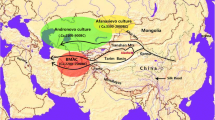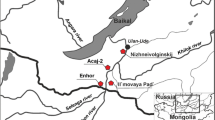Abstract
In the present work, DNA was extracted from 63 skeletal samples recovered at the Neolithic site of San Juan ante Portam Latinam (SJAPL) (Araba, Basque Country). These samples have proved useful as genetic material for the performance of population studies. To achieve this it was necessary to overcome the methodological problems arising when working with damaged DNA molecules. We succeeded in performing an amplification and restriction analysis of the polymorphisms present in the mtDNA. Ninety seven percent of the samples were classified as belonging to one of the nine mtDNA haplogroups described in Caucasians. This work shows that restriction analysis is a useful methodological tool to perform reliable population genetic analysis on archaeological remains. Tha analysis of ancient and modern haplogroup distribution can shed more light on the genetic evolution of human populations. Moreover, a more exhaustive data on prehistoric populations will allow to build stronger hypothesis on the genetic relationships among human populations.
Similar content being viewed by others
References
Aguirre A., Vicario A., Mazón L.I., Estomba A., Martínez de Pancorbo M., Arrieta Pico V., Pérez Elortondo F., Lostao C.M. (1991). Are the Basques a single and a unique population? American Journal of Human Genetics, 49: 450–458
Anderson S., Bankier A.T., Barrell B.G., Bruijn M.H.L.de, Coulson A.R., Drouin J., Eperon I.C., Nierlich D.P., Roe B.A., Sanger F., Schreier P.H., Smith A.J.H., Staden R., Young I.G. (1981). Sequence and organization of the human mitochondrial genome. Nature, 290: 457–465
Brown T.A. and Brown K.A. (1992). Ancient DNA and the archaeologist. Antiquity, 66: 1–23
Calafell F. and Bertranpetit J. (1994). Principal component analysis of gene frequencies and the origin of Basques. American Journal of Physical Anthropology, 93: 201–215
Cooper A. (1994). DNA from museum specimens. In Herrmann B. and Hummel S. (eds) Ancient DNA. Recovery and analysis of genetic material from paleontological, archaeological, museum, medical, and forensic specimen. New York: Springer-Verlag, pp. 149–165
Chen Y.-S., Torroni A., Excoffier L. Santachiara-Benerecetti A.S., Wallace D.C. (1995). Analysis of mtDNA variation in African populations reveals the most ancient of all human continent-specific haplogroups. American Journal of Human Genetics, 57: 133–149
de la Rúa C., Baraybar J.P., Cuende M., Manzano C. (1995). La sepultura colectiva de San Juan ante Portam Latinam (Laguardia, Alava): contribución de la Antropología a la interpretación del ritual funerario. Rubricatum (I Congreso del Neolítico de la Península Ibérica), 1: 585–589
Doran G.H., Dickel D.N., Ballinger W.E.Jr., Agee O.F., Laipis P.J., Hauswirth W.W. (1986). Anatomical, cellular and molecular analysis of 8,000-year old human brain tissue from the Windower archaeological site. Nature, 323: 803–806
Etxeberria F. and Vegas J.I. (1988). Agresividad social o guerra? Durante el neo-eneolítico en la cuenca media del valle del Ebro, a propósito de San Juan Ante Portam Latinam (Rioja Alavesa). Munibe (Antropología-Arqueología), 6: 105–112
Ginther C., Issel-Tarver L., King M.C. (1992). Identifying individuals by sequencing mitochondrial DNA from teeth. Nature Genetics, 2: 135–138
Hagelberg E. (1994). Mitochondrial DNA from ancient bones. In Herrmann B. and Hummel S. (eds) Ancient DNA. Recovery and analysis of genetic material from paleontological, archaeological, museum, medical, and forensic specimens. New York: Springer-Verlag, pp. 195–204
Hagelberg E. and Clegg J.B. (1991). Isolation and characterization of DNA from archaeological bone. Proceedings of the Royal Society of London B, 244: 45–50
Handt O., Richards M., Trommsdorff M., Kilger C., Simanainen J., Georgiev O., Bauer K., Stone A., Hedges R., Schaffner W., Utermann G., Sykes B., Pääbo S. (1994). Molecular genetic analyses of the Tyrolean Ice Man. Science, 264: 1775–1778
Higuchi R, (1992). Dr. Russ' problem corner. Ancient DNA Newsletter, 1: 6–8
Higuchi R.G., Wrischnik L.A., Oakes E., George M., Tong B., Wilson A.C. (1987). Mitochondrial DNA of the extinct quagga: relatedness and extent of postmortem change. Journal of Molecular Evolution, 25: 283–287
Higuchi R.G., Bowman B., Freiberger M., Ryder O.A., Wilson A.C. (1984). DNA sequences from the quagga, an extinct member of the horse family. Nature, 312: 282–284
Hummel S. and Herrman B. (1994). General aspects of sample preparation. In Herrmann B. and Hummel S. (eds) Ancient DNA. Recovery and analysis of genetic material from paleontological, archaeological, museum, medical, and forensic specimens. New York: Springer-Verlag, pp. 59–68
Iriondo M., de la Rúa C., Manzano C. (1999). Una nueva perspectiva sobre la estructura genética de la población vasca peninsular: inferencias acerca del efecto del flujo génico y la deriva genética. Revista Española de Antropología Biológica, 20: 181–193
Izagirre N. and de la Rúa C. (1999). An mtDNA analysis in ancient Basque populations: implications for haplogroup V as a marker for a major Paleolithic expansion from sothwestern Europe. American Journal of Human Genetics, 65: 199–207
Krings M., Stone A., Schmitz R.W., Krainitz H., Stoneking M., Pääbo S. (1997). Neanderthal DNA sequences and the origin of modern humans. Cell, 90: 19–30
Macaulay V., Richards M., Hickey E., Vega E., Cruciani F., Guida V., Scozzari R., Bonné-Tamir B., Sykes B., Torroni T. (1999). The emerging tree of West Eurasian mtDNAs: a synthesis of control-region sequences and RFLPs. American Journal of Human Genetics, 64: 232–249
Lalueza C. (1996). Analysis of ancient mitochondrial DNA from extinct aborigenes from Tierra del Fuego-Patagonia. Ancient Biomolecules, 1: 43–54
Manzano C., Orue J.M., de la Rúa C. (1996). The “Basqueness” of the Basques of Alava: a reappraisal from a multidisciplinary perspective. American Journal of Physical Anthropology, 99: 249–258
Merriwether D.A., Rothhammer F., Ferrell R.E. (1994). Genetic variation in the New World: ancient teeth, bone, and tissue as sources of DNA. Experientia, 50: 592–601
Montiel R., Malgosa A., Francalacci P. (1999). Autentificación del ADN antiguo. XI Congreso de la Soc. Española de Antropología Biológica, Santiago de Compostela. (in press)
Mullis K.B. and Faloona F.A. (1987). Specific synthesis of DNA in vitro via a polymerase-catalysed chain reaction. Methodologies in Enzymology, 155: 335–350
Nei M. (1987). Molecular Evolutionary Genetics Columbia University Press, New York, NY.
O'Rourke D.H., Carlyle S.W., Parr R.L. (1996). Ancient DNA: methods, progress, and perspectives. American Journal of Human Biology, 8: 557–571
Pääbo S. (1986). Molecular genetic investigations of ancient human remains. Cold Spring Harbor Symposia on Quantitative Biology, LI: 441–446
Pääbo S., Irwin D.M., Wilson A.C. (1990). DNA damage promotes jumping between templates during enzimatic amplification. Journal of Biological Chemistry, 15: 4718–4721
Pääbo S. and Wilson A.C. (1988). Polymerase chain reaction reveals cloning artefacts. Nature, 334: 387–388
Parr R.L., Carlyle S.W., O'Rourke D.H. (1996). Ancient DNA analysis of Fremont Amerindians of the Great Salt Lake Wetlands. American Journal of Physical Anthropology, 99: 507–518
Richards M., Smaleey K., Sykes B., Hedges R. (1993). Archaeology and genetics: analysing DNA from skeletal remains. World Archaeology, 25: 18–28
Rogan P.K. and Salvo J.J. (1990). Study of nucleic acids isolated from ancient remains. Yearbook of Physical Anthropology, 33: 195–214
Saiki R.C., Gelfand D.H., Stoffel S., Scharf S., Higuchi R., Horn G.T., Mullis K.B., Erlich H.A. (1988). Primer-directed enzymatic amplification of DNA with a thermostable DNA polymerase. Science, 239: 487–491
Saiki R.K., Scharf S., Faloona F., Mullis K.B., Horn G.T., Erlich H.A., Arnheim N. (1985). Enzymatic amplification of bð-globulin genomic sequences and restriction site analysis for diagnosis of sickle cell anemia. Science, 230: 1850–1854
Stone A. and Stoneking M. (1998). mtDNA analysis of a prehistoric Oneota population: implications for the peopling of the New World. American Journal of Human Genetics, 62: 1153–1170
Stone A. and Stoneking M. (1993). Ancient DNA from pre-columbian amerindian population. American Journal of Physical Anthropology, 92: 463–471
Thuesen I. and Engberg J. (1990). Recovery and analysis of human genetic material from mummified tissue and bone. Journal of Archaeological Sciences, 17: 679–689
Torroni A., Bandelt H.-J., D'urbano L., Lahermo P., Moral P., Sellitto D., Rengo C., Forster P., Savontaus M.-L., Bonne-Tamir B., Scozzari R. (1998). MtDNA analysis reveals a major late Palaeolithic population expansion from southwestern to northeastern Europe. American Journal of Human Genetics, 62: 1137–1152
Torroni A., Huoponen K., Francalacci P., Petrozzi M., Morelli L., Scozzari R., Obinu D., Savontaus M-l., Wallace D.C. (1996). Classification of European mtDNAs from an analysis of three European populations. Genetics, 144: 1835–1850
Torroni A. and Wallace D.C. (1995). mtDNA Haplogroups in Native Americans. American Journal of Human Genetics, 56: 1234–1235.
Torroni A., Lott M.T., Cabell M.F., Chen Y.-S., Lavergne L., Wallace D.C. (1994). MtDNA and the origin of caucasians: identification of ancient caucasian-specific haplogroups, one of which is prone to recurrent somatic duplication in the D-loop region. American Journal of Human Genetics, 55: 760–776
Tuross N. (1994). The biochemistry of ancient DNA in bone. Experientia, 50: 530–535
Yang D.Y., Eng B., Waye J.S., Dudar J.C., Saunders S.R. (1998). Technical Note: Improved DNA extraction from ancient bones using silica-based spin columns. American Journal of Physical Anthropology, 105: 539–543.
Author information
Authors and Affiliations
Rights and permissions
About this article
Cite this article
Izaguirre, N., De La Rua, C. Ancient mtDNA haplogroups: a new insight into the genetic history of European populations. Int. J. Anthropol. 17, 27–40 (2002). https://doi.org/10.1007/BF02447902
Received:
Accepted:
Issue Date:
DOI: https://doi.org/10.1007/BF02447902




